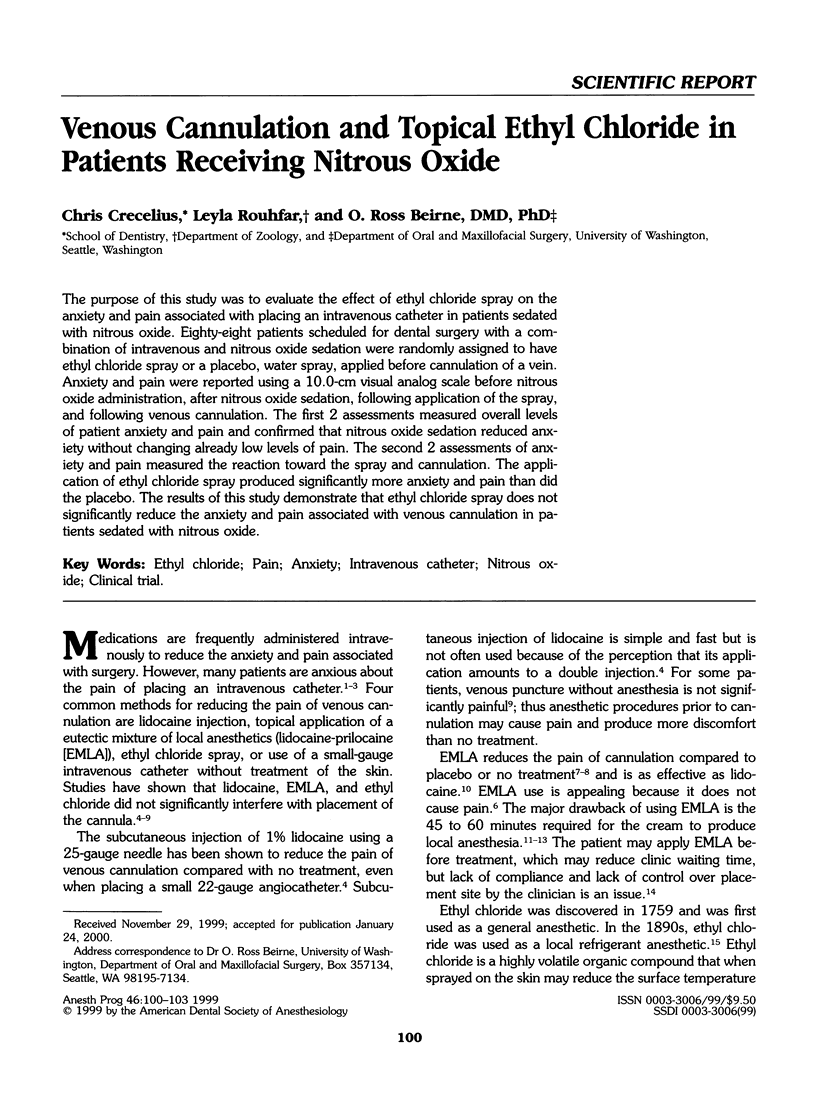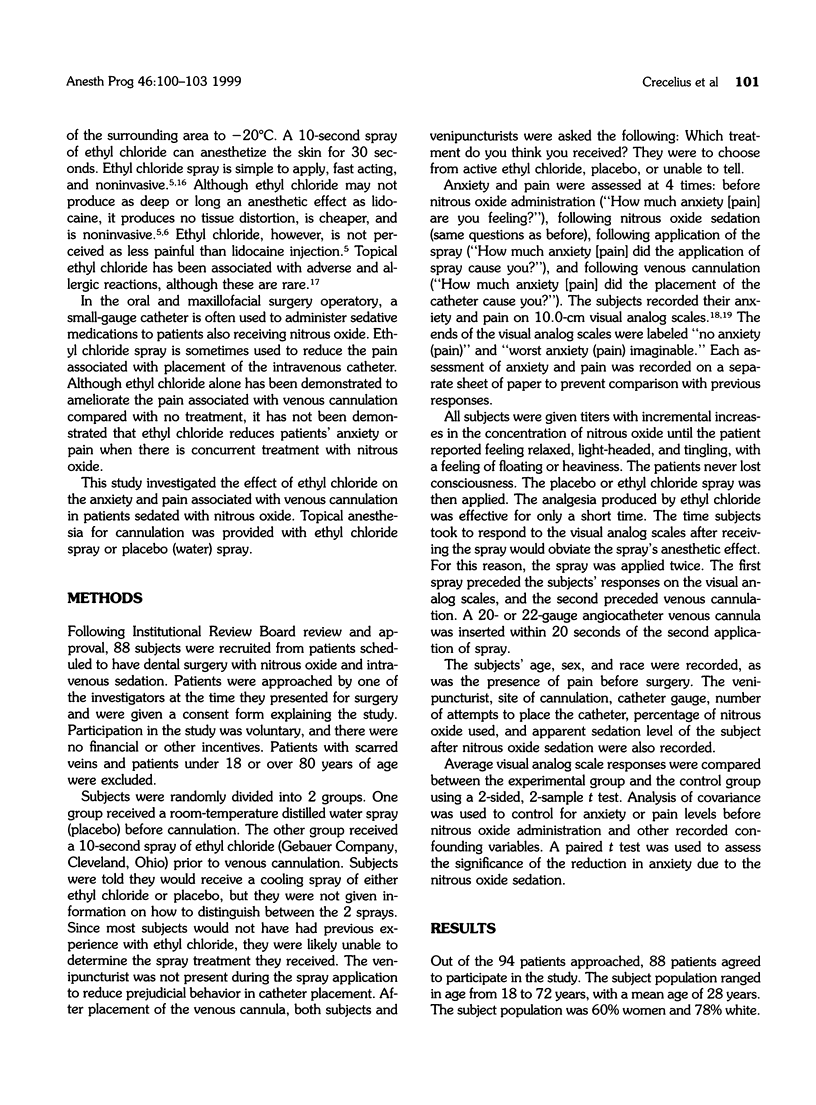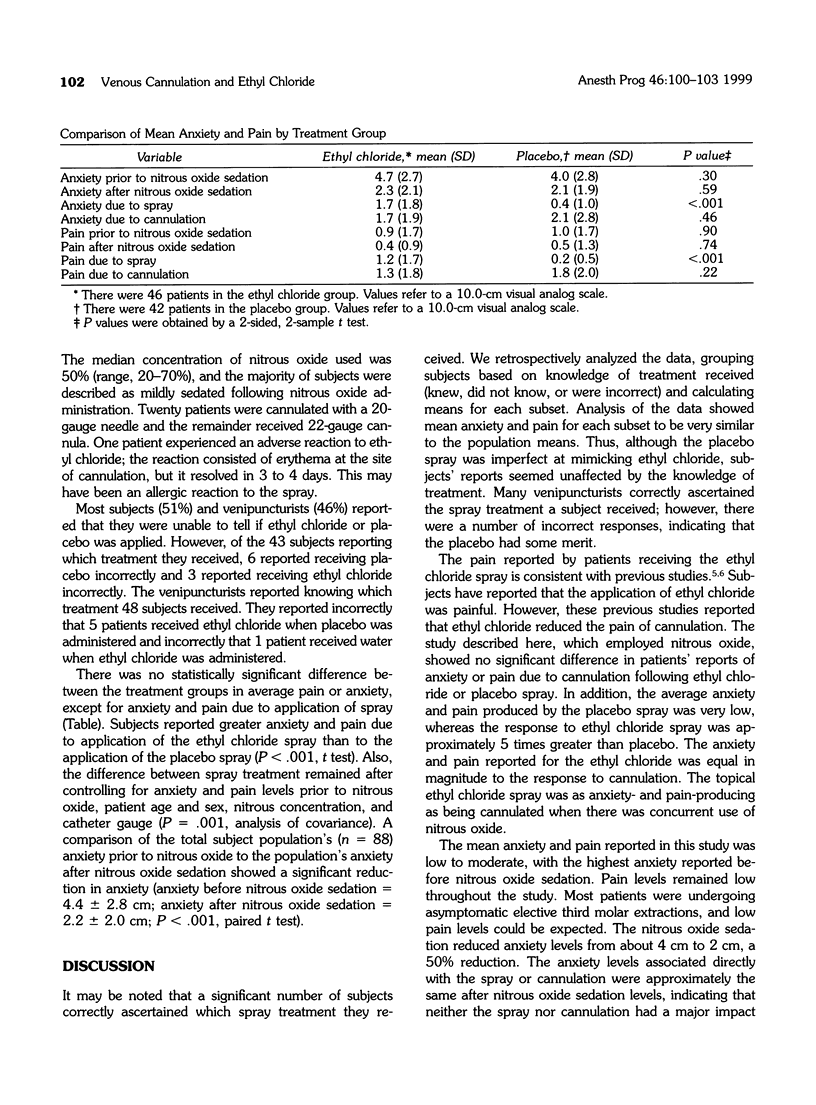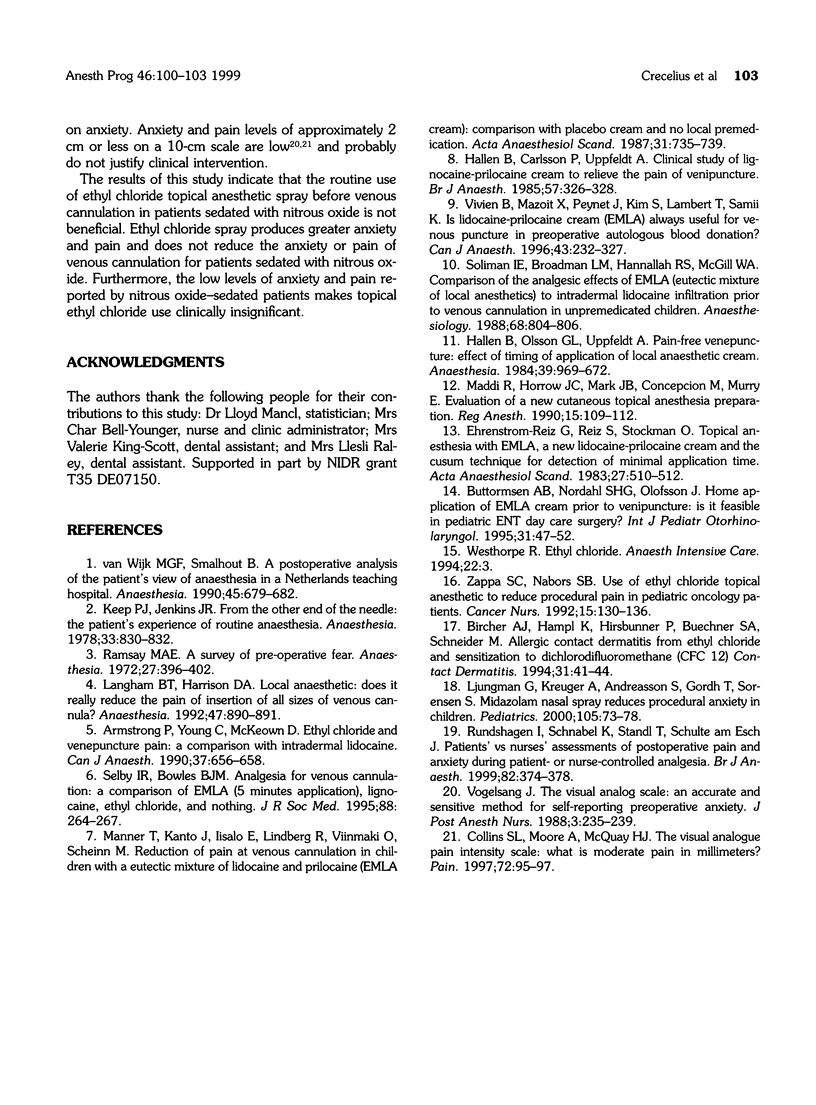Abstract
The purpose of this study was to evaluate the effect of ethyl chloride spray on the anxiety and pain associated with placing an intravenous catheter in patients sedated with nitrous oxide. Eighty-eight patients scheduled for dental surgery with a combination of intravenous and nitrous oxide sedation were randomly assigned to have ethyl chloride spray or a placebo, water spray, applied before cannulation of a vein. Anxiety and pain were reported using a 10.0-cm visual analog scale before nitrous oxide administration, after nitrous oxide sedation, following application of the spray, and following venous cannulation. The first 2 assessments measured overall levels of patient anxiety and pain and confirmed that nitrous oxide sedation reduced anxiety without changing already low levels of pain. The second 2 assessments of anxiety and pain measured the reaction toward the spray and cannulation. The application of ethyl chloride spray produced significantly more anxiety and pain than did the placebo. The results of this study demonstrate that ethyl chloride spray does not significantly reduce the anxiety and pain associated with venous cannulation in patients sedated with nitrous oxide.
Full text
PDF



Selected References
These references are in PubMed. This may not be the complete list of references from this article.
- Armstrong P., Young C., McKeown D. Ethyl chloride and venepuncture pain: a comparison with intradermal lidocaine. Can J Anaesth. 1990 Sep;37(6):656–658. doi: 10.1007/BF03006485. [DOI] [PubMed] [Google Scholar]
- Bircher A. J., Hampl K., Hirsbrunner P., Buechner S. A., Schneider M. Allergic contact dermatitis from ethyl chloride and sensitization to dichlorodifluoromethane (CFC 12). Contact Dermatitis. 1994 Jul;31(1):41–44. doi: 10.1111/j.1600-0536.1994.tb01904.x. [DOI] [PubMed] [Google Scholar]
- Collins S. L., Moore R. A., McQuay H. J. The visual analogue pain intensity scale: what is moderate pain in millimetres? Pain. 1997 Aug;72(1-2):95–97. doi: 10.1016/s0304-3959(97)00005-5. [DOI] [PubMed] [Google Scholar]
- Ehrenström-Reiz G., Reiz S., Stockman O. Topical anaesthesia with EMLA, a new lidocaine-prilocaine cream and the Cusum technique for detection of minimal application time. Acta Anaesthesiol Scand. 1983 Dec;27(6):510–512. doi: 10.1111/j.1399-6576.1983.tb01997.x. [DOI] [PubMed] [Google Scholar]
- Guttormsen A. B., Nordahl S. H., Olofsson J. Home application of EMLA cream prior to venipuncture. Is it feasible in pediatric ENT day care surgery? Int J Pediatr Otorhinolaryngol. 1995 Jan;31(1):47–52. doi: 10.1016/0165-5876(94)01073-7. [DOI] [PubMed] [Google Scholar]
- Hallén B., Carlsson P., Uppfeldt A. Clinical study of a lignocaine-prilocaine cream to relieve the pain of venepuncture. Br J Anaesth. 1985 Mar;57(3):326–328. doi: 10.1093/bja/57.3.326. [DOI] [PubMed] [Google Scholar]
- Hallén B., Olsson G. L., Uppfeldt A. Pain-free venepuncture. Effect of timing of application of local anaesthetic cream. Anaesthesia. 1984 Oct;39(10):969–972. doi: 10.1111/j.1365-2044.1984.tb08884.x. [DOI] [PubMed] [Google Scholar]
- Keep P. J., Jenkins J. R. From the other end of the needle. The patient's experience of routine anaesthesia. Anaesthesia. 1978 Oct;33(9):830–832. doi: 10.1111/j.1365-2044.1978.tb08502.x. [DOI] [PubMed] [Google Scholar]
- Langham B. T., Harrison D. A. Local anaesthetic: does it really reduce the pain of insertion of all sizes of venous cannula? Anaesthesia. 1992 Oct;47(10):890–891. doi: 10.1111/j.1365-2044.1992.tb03157.x. [DOI] [PubMed] [Google Scholar]
- Ljungman G., Kreuger A., Andréasson S., Gordh T., Sörensen S. Midazolam nasal spray reduces procedural anxiety in children. Pediatrics. 2000 Jan;105(1 Pt 1):73–78. doi: 10.1542/peds.105.1.73. [DOI] [PubMed] [Google Scholar]
- Maddi R., Horrow J. C., Mark J. B., Concepcion M., Murray E. Evaluation of a new cutaneous topical anesthesia preparation. Reg Anesth. 1990 May-Jun;15(3):109–112. [PubMed] [Google Scholar]
- Manner T., Kanto J., Iisalo E., Lindberg R., Viinamäki O., Scheinin M. Reduction of pain at venous cannulation in children with a eutectic mixture of lidocaine and prilocaine (EMLA cream): comparison with placebo cream and no local premedication. Acta Anaesthesiol Scand. 1987 Nov;31(8):735–739. doi: 10.1111/j.1399-6576.1987.tb02655.x. [DOI] [PubMed] [Google Scholar]
- Ramsay M. A. A survey of pre-operative fear. Anaesthesia. 1972 Oct;27(4):396–402. doi: 10.1111/j.1365-2044.1972.tb08244.x. [DOI] [PubMed] [Google Scholar]
- Rundshagen I., Schnabel K., Standl T., Schulte am Esch J. Patients' vs nurses' assessments of postoperative pain and anxiety during patient- or nurse-controlled analgesia. Br J Anaesth. 1999 Mar;82(3):374–378. doi: 10.1093/bja/82.3.374. [DOI] [PubMed] [Google Scholar]
- Selby I. R., Bowles B. J. Analgesia for venous cannulation: a comparison of EMLA (5 minutes application), lignocaine, ethyl chloride, and nothing. J R Soc Med. 1995 May;88(5):264–267. [PMC free article] [PubMed] [Google Scholar]
- Soliman I. E., Broadman L. M., Hannallah R. S., McGill W. A. Comparison of the analgesic effects of EMLA (eutectic mixture of local anesthetics) to intradermal lidocaine infiltration prior to venous cannulation in unpremedicated children. Anesthesiology. 1988 May;68(5):804–806. doi: 10.1097/00000542-198805000-00025. [DOI] [PubMed] [Google Scholar]
- Vivien B., Mazoit X., Peynet J., Kim S., Lambert T., Samii K. Is lidocaine-prilocaine cream (EMLA) always useful for venous puncture in preoperative autologous blood donation? Can J Anaesth. 1996 Mar;43(3):232–237. doi: 10.1007/BF03011740. [DOI] [PubMed] [Google Scholar]
- Vogelsang J. The Visual Analog Scale: an accurate and sensitive method for self-reporting preoperative anxiety. J Post Anesth Nurs. 1988 Aug;3(4):235–239. [PubMed] [Google Scholar]
- Westhorpe R. Ethyl chloride. Anaesth Intensive Care. 1994 Feb;22(1):3–3. doi: 10.1177/0310057X9402200101. [DOI] [PubMed] [Google Scholar]
- Zappa S. C., Nabors S. B. Use of ethyl chloride topical anesthetic to reduce procedural pain in pediatric oncology patients. Cancer Nurs. 1992 Apr;15(2):130–136. [PubMed] [Google Scholar]
- van Wijk M. G., Smalhout B. A postoperative analysis of the patient's view of anaesthesia in a Netherlands' teaching hospital. Anaesthesia. 1990 Aug;45(8):679–682. doi: 10.1111/j.1365-2044.1990.tb14399.x. [DOI] [PubMed] [Google Scholar]


